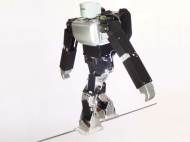PRIMER V4 – a steel wire crossing robot
 Japanese robotics researcher Masahiko Yamaguchi, who represents himself as Dr. Guero in other robotics projects, modified a Kondo KHR-3HV hobby kit robot and created a robot dubbed PRIMER V4. This two-legged hobby-kit robot was modified in a way that allows it to balance and cross over a 4-mm (0.16-inch) thick and 1 meter (3 feet) long steel wire. While it doesn’t mimic the way humans cross the wire and it is a bit slow, it is still quite impressive.
Japanese robotics researcher Masahiko Yamaguchi, who represents himself as Dr. Guero in other robotics projects, modified a Kondo KHR-3HV hobby kit robot and created a robot dubbed PRIMER V4. This two-legged hobby-kit robot was modified in a way that allows it to balance and cross over a 4-mm (0.16-inch) thick and 1 meter (3 feet) long steel wire. While it doesn’t mimic the way humans cross the wire and it is a bit slow, it is still quite impressive.
Masahiko Yamaguchi has worked at some prestigious labs, including Japan’s National Institute of Advanced Industrial Science and Technology, Boston Dynamics, and Osaka University. His nickname Dr. Guero was chosen by his wife, and it originates from the long-running comic and animated television show Dragon Ball Z, where an evil scientist named Dr. Gero creates Red Ribbon Androids. Unlike Dr. Gero from Dragon Ball Z, the research performed by Dr. Guero thus far seems to be related to robot balance in various occasions (as you can see in the video compilation bellow).
In his latest project, Dr. Guero modified the $1,800 Kondo KHR-3HV hobby kit robot (information available in Japanese language) in a couple of ways which allowed the robot to achieve balance and keep its contact with the wire.
The first choice was to make the robot wireless in order to eliminate the influence of wires in its balance. That meant that its power supply had to be integrated into the robot and all the control had to be achieved wirelessly. The control itself isn’t fully automated yet, mainly because it would require an advanced sensory system and more complicated control algorithms which adjust posture and start different sequences of its crossing.
Another modification of the robot is in its arms which were replaced with a simpler version. This modification was applied in order to simplify and increase balance control. While the length of the arm is the same, Dr. Guero chose that PRIMER v4 should have arms with fewer joints in order to avoid vibrations and backlashes which occur in the joints of the robot’s regular arm.
The most important modification which allows the robot to inch its way along the wire was in its feet. The feet have additional grooves to catch the wire in a way similar to humans who cross the tight rope use their toes. This modification allows the robot to inch its way across the wire while sliding on it, rather than walking. Dr. Guero believes it is possible to modify the PRIMER V4 to enable its walking across the steel wire with development of a mechanism of indirect path, however, he choose to use a simpler version for the moment due to vibrations in leg joints during its walking.
In order to achieve balance, the robot is semi-autonomous because it relies on user input related to posture and sequences it needs to perform, however, it also relies on an algorithm which uses the information from its gyro in order to achieve balance, and Dr. Guero (page available in Japanese language) developed a walking algorithm which uses a smooth curve applied to the beginning and end of the servo drive rather than steep control in order to minimize the vibrations and simplify the control during the crossing process.
If you are interested about the robot’s specifications, hang on during the day because an article about the Kondo KHR-3HV is in the making.









Leave your response!